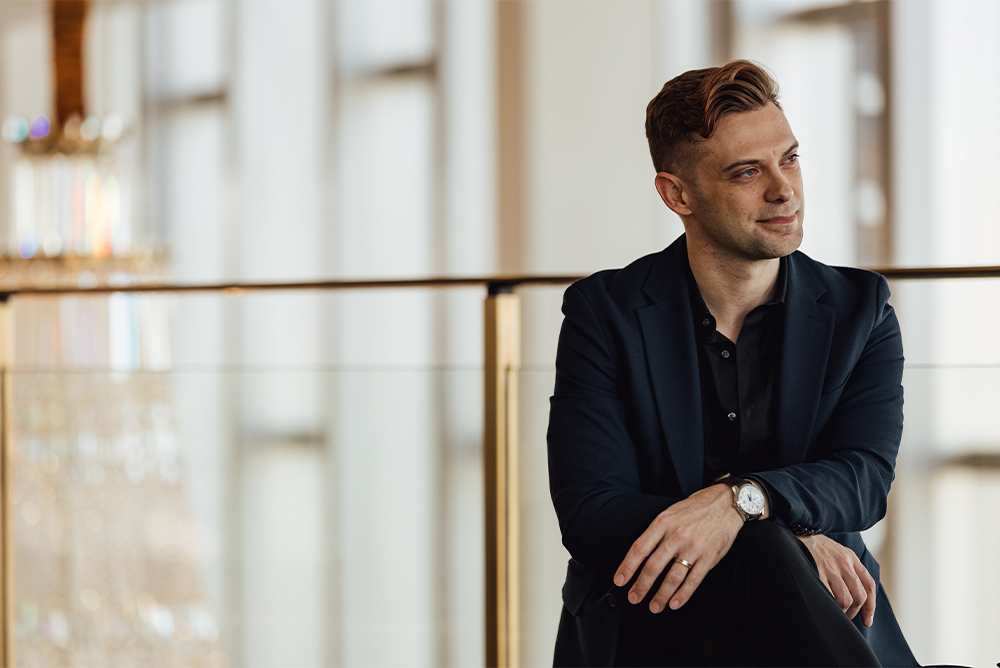
Photo by Chad Brady.
Michael Novak is the artistic director of the Paul Taylor Dance Company. Before joining us for this week’s Zócalo/The Music Center conversation, “How Is Art A Weapon in War?,” presented at Jerry Moss Plaza in downtown Los Angeles, he spoke to us in the green room about Phantom of the Opera, what keeps him going, and the borrowed technique of pausing.
Where was your favorite place to go growing up?
My mom and I would always go to Woodfield Mall. This is back when there was Marshall Fields. And Marshall Fields had this little cafe on the second or third floor and we would always go there for Christmas shopping and to get lunch at Marshall Fields. So that was always a special memory. And then in the middle of Woodfield Mall there used to be this water fountain feature. And we would always get in Mrs. Fields cookies, and we bring it to the water fountain. And we’d sit and we would like to have a cookie; that was like our break from the day.
When are you at your most creative?
Usually between 5 a.m. and 10 a.m. That’s when I’m most on my game. That’s when the most ideas are flowing. I journal every morning and that’s when I get out ideas for programming, ideas for casting, ideas for touring.
What’s the first performance you remember watching that really stuck with you?
Phantom of the Opera. The first national tour. It would have been 1988-1989. We sat in the first couple of rows. And when the chandelier comes crashing down, I thought it was going to crash on us. I was 6 years old. I remember I couldn’t understand how they created that world on stage and the theatricality of it and the drops and the music and the chandelier lifting, there was so much magic in that show. And that was definitely my first jaw-on-the-floor moment of realizing what theater could do.
Phantom just closed on Broadway. How do you feel about it?
I saw it like two months ago. It was funny because I was wondering, is it still as good or was I just like 6 years old and in awe? But the theatricality of it is extraordinary. The set transitions, the production elements—the orchestra is massive—it was and is a bombastic musical from the production side. And still incredibly effective and profound.
You wrote your thesis on dance photographer George Platt Lynes. What drew you to him?
I was looking at the souvenir programs that a lot of dance companies were creating when they were touring in the mid-20th century, looking at the aesthetic of how dance was being kind of born in America, essentially. And of all the souvenir programs that I was looking at, it was the photos of George Platt Lynes with Ballet Caravan. This is before New York City Ballet was New York City Ballet. And I thought his photos were incredibly stunning. There was an eroticism to them. There was a surrealist element. There was a fashion look to them as well. And I just thought they were hauntingly beautiful.
What’s a dance style you haven’t done yet that you want to try?
My husband wants me to do West Coast Swing.
What’s holding you back from trying it?
I just need a break from dancing. When I have my downtime, I don’t want to be focused on dancing. I want something that’s very different that I manage on a day-to-day basis.
OK, what is one thing you like to do in your downtime?
Nap?
You don’t have downtime. Wow, I’ll reframe that. What keeps you going?
The dancers in the company keep me going, because of the work that they do and their dedication to Paul and to our art form and watching them grow and take on new risks day after day after day, especially working through the entire pandemic, and their perseverance as a collective. Not just generating art, but the community that they’ve built.
Everything I do is trying to figure out how to set them up for success as best I can. Pandemic notwithstanding. There’s so many moments on a night-to-night basis where I see them unpacking more and more about their artistry, and I get so excited to figure out what is that next opportunity and challenge for them to keep growing. I’m so lucky that I get to watch amazing dance come to life and watch these artists find out who they are through it.
Speaking of Paul, what’s one thing that you hear him saying on your shoulder after every performance?
Paul was really big about gesture, and letting gesture read clearly for audiences. And the bigger the house, the more you have to make sure that you give enough space between sending a gesture and letting it read. So he would often say pause a lot. Like pause, then gesture, so that the audience all the way back got to read it rather than just rushing through something. As a dancer it was funny, because it feels so exaggerated. I was, like, fine, I’ll pause. And now that I’m on the other side, I’m like, oh my god, the dancers need to pause. And I’m like dancers, pause. And those that worked with Paul are like, are you serious? And I’m, like, I’m telling you, he was right!
He was a man of few words but he was really big on [the fact that] you can’t appreciate big moments without small moments. You really need to understand the contrast of chaos and stillness. If things are too still, you can get bored. If things are too chaotic, you can get bored. We have to build that ebb and flow. I think works that tend to be extraordinarily complex have that range—loud to soft, chaotic to symmetry, comedic to tragic. Profound works always give you that depth and pathos.



